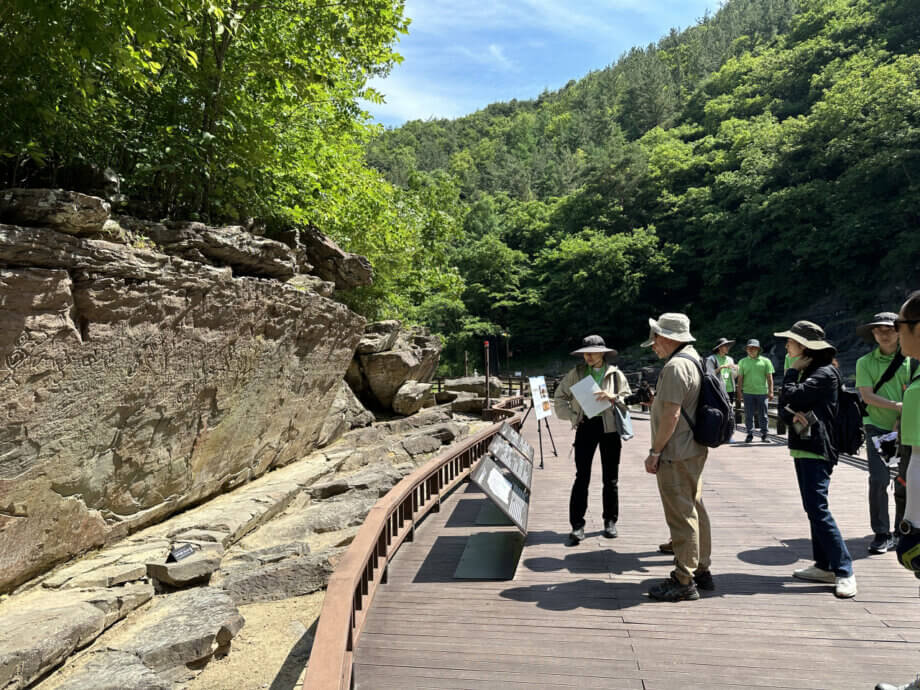South Korea’s Prehistoric Petroglyphs Gain UNESCO World Heritage Status
In a landmark decision, UNESCO has inscribed the prehistoric rock carvings along the Bangucheon Stream in Ulsan, South Korea, onto its prestigious World Heritage list. This recognition, announced during the 47th session of the UNESCO World Heritage Committee in Paris, marks a significant milestone for South Korea’s cultural heritage and highlights the global importance of these ancient artworks.
- South Korea’s Prehistoric Petroglyphs Gain UNESCO World Heritage Status
- What Are the Bangucheon Stream Petroglyphs?
- Why Are These Petroglyphs So Important?
- Challenges in Preserving the Petroglyphs
- South Korea’s Growing List of World Heritage Sites
- Understanding Petroglyphs: Windows into Prehistoric Life
- International Recognition and Future Prospects
- In Summary
What Are the Bangucheon Stream Petroglyphs?
The petroglyphs, or rock carvings, are etched into the vertical cliff faces along the Bangucheon Stream, a tributary of the Taehwa River in Ulsan, approximately 360 kilometers southeast of Seoul. These carvings are believed to date back to the prehistoric era, with some estimates placing their creation as far as 6,000 years ago. The images depict a variety of scenes, including hunting expeditions and animals, offering a rare glimpse into the lives and beliefs of early inhabitants of the Korean Peninsula.
The newly inscribed World Heritage property comprises two major panels: the Bangudae petroglyphs in Daegok-ri and the Cheonjeon-ri petroglyphs. Both are considered exceptional examples of early human artistic expression in East Asia and are among the most significant archaeological sites in Korea.
Bangudae Petroglyphs: Korea’s Largest Rock Art Site
The Bangudae petroglyphs, located in Daegok-ri, are the largest rock art site on the Korean Peninsula. The main panel stretches over 30 meters, with carvings concentrated on a rock face about 4.5 meters high and eight meters wide. These engravings include images of both sea and land animals, as well as detailed hunting scenes. Notably, the site features what is believed to be the world’s oldest known depiction of whale hunting, underscoring the advanced observational skills and artistic abilities of its creators.
First discovered in 1971, the Bangudae panel was designated as South Korea’s National Treasure No. 285. A 2023 report by the Ulsan metropolitan city, utilizing three-dimensional scanning technology, identified 312 individual engravings on the panel, further highlighting its complexity and richness.
Cheonjeon-ri Petroglyphs: A Treasure Trove of Prehistoric Art
Located about two kilometers from the Bangudae site, the Cheonjeon-ri petroglyphs were discovered in 1970, a year before their more famous neighbor. This site contains over 620 figures, symbols, and drawings engraved along a rock surface measuring approximately 2.7 meters high and 10 meters wide. The Cheonjeon-ri petroglyphs are now recognized as South Korea’s National Treasure No. 147.
Together, these two sites provide invaluable insight into the spiritual and daily lives of prehistoric communities, as well as their relationship with the natural world.
Why Are These Petroglyphs So Important?
The Bangucheon Stream petroglyphs are not only remarkable for their age and artistic quality but also for the stories they tell about early human societies. The carvings depict a wide range of animals, including whales, tigers, deer, and turtles, as well as scenes of communal hunting and ritual activities. These images suggest a sophisticated understanding of the environment and a complex social structure among the people who created them.
UNESCO’s advisory body, the International Council on Monuments and Sites (ICOMOS), recommended the listing of the petroglyphs in May, noting that they offer “outstanding testimony to a tradition of rock art that spanned some 6,000 years.” The World Heritage Committee further praised the realistic depictions and distinctive compositions, stating that they “highlight the artistic skills of the people who once lived on the Korean Peninsula.”
The committee described the carvings as “masterpieces created through the creativity of prehistoric people.”
This recognition places the Bangucheon Stream petroglyphs alongside other globally significant rock art sites, such as the petroglyphs of Alta in Norway and the Côa Valley in Portugal, underscoring their universal value.
Challenges in Preserving the Petroglyphs
Despite their cultural and historical significance, the petroglyphs have faced considerable preservation challenges. One of the most pressing issues is their frequent submergence due to fluctuating water levels at the nearby Sayeon Dam. Constructed in 1965, before the petroglyphs were discovered, the dam has caused the carvings to be underwater for an average of 42 days per year over the past decade.
This repeated submersion has raised concerns among conservationists and government officials about the long-term survival of the rock art. The water not only erodes the carvings but also promotes the growth of algae and other organisms that can further damage the stone surfaces.
Efforts to address these challenges have included discussions about adjusting the dam’s water levels and constructing temporary embankments to protect the sites. Authorities are currently planning to install floodgates at the Sayeon Dam spillway, which would allow for better control of water levels and help safeguard the petroglyphs from future flooding.
According to a statement from the World Heritage Committee, “The South Korean government is recommended to inform the World Heritage Centre of the progress of the dam-related construction work.”
The preservation of the petroglyphs was a key factor in the lengthy process of achieving World Heritage status. The site was first placed on UNESCO’s tentative list in 2010, but it took 15 years to address the committee’s concerns and secure the final inscription.
South Korea’s Growing List of World Heritage Sites
With the addition of the Bangucheon Stream petroglyphs, South Korea now boasts 17 entries on the UNESCO World Heritage list. These sites range from ancient palaces and temples to natural wonders and industrial heritage, reflecting the country’s rich and diverse history.
Other notable World Heritage sites in South Korea include the Jongmyo Shrine, the Changdeokgung Palace Complex, the Gyeongju Historic Areas, and the volcanic island of Jeju. Each of these sites offers unique insights into different periods and aspects of Korean civilization.
The inclusion of the petroglyphs not only enhances South Korea’s international cultural profile but also brings renewed attention to the importance of preserving and studying prehistoric art. It serves as a reminder of the deep roots of human creativity and the enduring legacy of our ancestors.
Understanding Petroglyphs: Windows into Prehistoric Life
Petroglyphs are images created by removing part of a rock surface through incising, picking, carving, or abrading. They are found all over the world and are among the oldest forms of human expression. Unlike pictographs, which are painted onto rock surfaces, petroglyphs are physically carved into the stone, making them more durable but also susceptible to erosion and other environmental threats.
The Bangucheon Stream petroglyphs are particularly significant because they provide direct evidence of the beliefs, rituals, and daily activities of prehistoric communities. The detailed depictions of animals and hunting scenes suggest a society deeply connected to its environment and reliant on collective effort for survival.
Experts believe that the carvings may have served multiple purposes, including recording important events, marking territorial boundaries, or serving as part of religious or shamanistic rituals. The presence of whale hunting scenes, for example, indicates a sophisticated knowledge of marine life and suggests that early Koreans engaged in organized group hunting long before written records began.
International Recognition and Future Prospects
The UNESCO World Heritage designation is expected to bring increased international attention and tourism to the Bangucheon Stream petroglyphs. This, in turn, could provide additional resources for conservation and research, helping to ensure that these ancient artworks are preserved for future generations.
However, increased tourism also brings new challenges, such as the risk of physical damage from visitors and the need for effective site management. Balancing public access with preservation will be a key task for South Korean authorities in the coming years.
Dr. Kim Jae-hyun, a leading archaeologist at the Ulsan National Institute of Science and Technology, commented, “The World Heritage status is a recognition of the universal value of these petroglyphs, but it also comes with a responsibility to protect and study them. We must work together to ensure that they remain a source of inspiration and knowledge for generations to come.”
Ongoing research, including advanced imaging and 3D scanning, continues to reveal new details about the petroglyphs and their creators. These technologies allow experts to document the carvings in high resolution, monitor their condition, and develop more effective conservation strategies.
In Summary
- The prehistoric petroglyphs along the Bangucheon Stream in Ulsan, South Korea, have been inscribed on the UNESCO World Heritage list, recognizing their outstanding cultural and historical value.
- The site includes two major panels: the Bangudae petroglyphs, Korea’s largest rock art site, and the Cheonjeon-ri petroglyphs, both featuring hundreds of carvings depicting animals, hunting scenes, and symbolic figures.
- Preservation challenges, particularly due to submergence from the Sayeon Dam, have prompted ongoing efforts to protect the carvings, including plans to install floodgates and adjust water levels.
- The World Heritage status brings international recognition and increased responsibility for conservation, research, and sustainable tourism management.
- The petroglyphs offer a unique window into the lives, beliefs, and artistic achievements of prehistoric communities on the Korean Peninsula, enriching our understanding of human history.




